WHITE PAPER
Choosing the Right OTDR for your Datacenter
Download PDF
Overview
To ensure that fiber in datacenters is reliable, network professionals need a more accurate, easier, and faster methodology for assessing the integrity of the infrastructure.
Choosing the right device not only solves this new generation of datacenter testing requirements, but also helps professionals work efficiently, and increase network reliability.
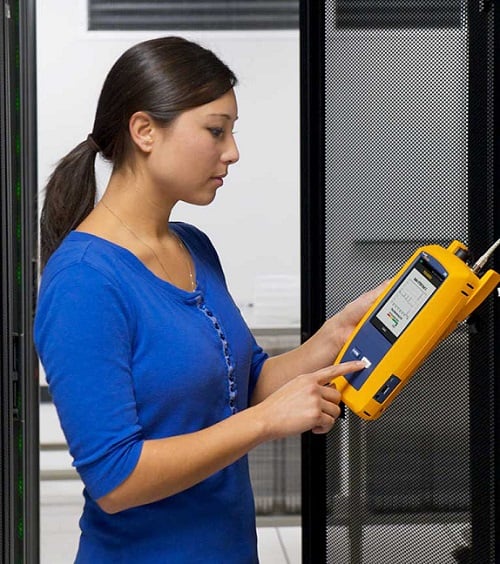
On This Page
- Introduction
- What is Driving Change in Fiber Technology?
- Important Criteria for Choosing a Datacenter OTDR
- OptiFiber® Pro: The Solution from Fluke Networks
- Summary
- DSX CableAnalyzer™ Series Copper Certification– Accelerates every step of the copper certification process
- CertiFiber® Pro – Accelerates every step of the fiber certification process
- FI-7000® – 1-second automated PASS/FAIL certification of fiber end-faces
Introduction
Server and network virtualization, coupled with the consolidation of enterprise networks, is driving significant change in the datacenter infrastructure. Not only are datacenters getting bigger and faster, but the architecture is becoming increasingly complex especially at the physical layer. The high-speed traffic exchange among servers, storage and networking devices consumes an ever-larger amount of fiber. Maintaining high availability with the diagnostic tools currently available is an almost impossible job. To ensure that fiber in datacenter is reliable, network professionals need a more accurate and faster methodology for assessing the integrity of the infrastructure. Such a shift in requirements renders most existing testing equipment obsolete and instead demands a new class of Optical Time Domain Reflectometer (OTDR) capable of characterizing and certifying enterprise fiber.
This white paper helps fiber installers and network technicians understand the key parameters for selecting a new OTDR. Choosing the right device not only solves this new generation of datacenter testing requirements, but also helps professionals work efficiently, and increase the reliability and value of the enterprise fiber network. We begin with a high-level overview of the changes datacenters are undergoing and the implications of these changes on fiber testing requirements. Then we’ll offer the criteria for selecting an OTDR to satisfy evolving requirements.
What is Driving Change in Fiber Technology?
Modular cabling systems
With its plug-and-play capability, modular or pre-terminated fiber cabling is gaining acceptance because it’s simpler and less costly to install than field-terminated cable. The challenge is that pre-terminated fiber is only guaranteed “good” as it exists in the manufacturer’s factory. It must then be transported, stored, and later bent and pulled during installation in the datacenter. All kinds of performance uncertainties are introduced before fiber cables are deployed. Proper testing of pre-terminated cables after installation is the only way to guarantee performance in a live application.
High-density and high-speed equipment in the datacenter
As datacenters grow larger, most enterprise IT departments look for ways to minimize power consumption and reduce expensive floor space. One strategy for reigning in operational expenses is datacenter consolidation using faster and higher-density networking and storage equipment. These new-generation devices are usually equipped with 10Gbps or faster fiber links to transport traffic. This shift is driving a significant uptick in the use of fiber in datacenters.
Datacenter owners responsible for keeping critical enterprise IT services available must now ensure that the fiber infrastructure is hardened.
With thousands of fibers being installed, they must be able to:
1. Fully certify and document that all fibers are installed correctly and for maximum efficiency.
2. Minimize fiber network downtime with the fastest possible problem resolution time.
Virtualization presents challenges along with advantages
The adoption of server and network virtualization dramatically affects datacenter networks. The implication is two-fold. First, virtualization consolidates multiple server resources onto fewer physical platforms. This creates much greater data traffic to and from virtualized platforms. Second, this traffic may pass to direct-attached storage or through a switch to network-attached storage, other servers, or to the greater enterprise network. Datacenters adapted to the requirements of virtualization by using End-of-Row (EoR) and Top-of-Rack (ToR) network topologies.
- EoR – topology places a switch at the logical end of a row of racks, replacing a single tier of home-run connections with two tiers of switches. Adding a second tier makes the network more adaptable. EoR shortens the length of the cables in the lower tier to the length of a row of racks. Shorter cables are generally easier to install and easier to change. EoR topology confines the impact of asset reconfiguration to a row of racks, rather than across an entire datacenter. EoR may reuse some elements of the existing physical network, however major upgrades are common.
-
ToR –topology dedicates an Ethernet switch to every rack. The ToR switch interconnects server, storage and networking assets in each rack and provides a trunk connection to an aggregation point in the datacenter. ToR also divides the physical connections into two tiers, but provides greater modularity inside a rack than the EoR topology.
Both EoR and ToR topologies support the bandwidth demands of virtualization and drive new cabling requirements. Intra-rack fibers in ToR configurations are typically less than 6 meters. To reduce clutter and improve equipment access, patch panels with short patch cords are usually employed to connect server, storage, and networking assets. This creates new problems:
1. A high concentration of fibers connecting the equipment to the patch panels can confuse installers regarding fiber polarity.
2. Short patch cords quality and workmanship defects are invisible to most fiber test equipment.
As virtualization marches forward, datacenter networks will fundamentally change. To deliver bandwidth to virtualized assets, 10Gbps, 40Gbps or 100Gbps links will be employed throughout the datacenter. Any uncertainty in the fiber links will jeopardize the stability and reliability of the network connected to those virtual servers. It is critical to have these fibers certified with channelized information and properly documented.
Important Criteria for Choosing a Datacenter OTDR
With the technological evolution occurring in datacenters, test requirements dramatically changed for the fiber networks that connect mission-critical servers, networking and storage devices. Selecting the proper OTDR to test your network not only strengthens its reliability, but also improves how quickly and efficiently the job is done, as well as documenting the quality of work. Here are some recommended criteria to consider, aside from the basic OTDR testing capabilities.
1. A simplified and task-focused user interface: Populating a datacenter with thousands of tested fibers is an enormously time consuming job. Maintaining fiber health is just as challenging and makes fast troubleshooting critical. A majority of OTDR's on the market today are designed to cover carrier applications. As a result, many have very complicated user interfaces, which require the user to grapple with numerous buttons and controls and navigate cumbersome multi-level menus. While this is suitable for the fiber enthusiasts who test Telco fiber on a daily basis, it’s a different story for enterprise network technicians. An OTDR designed around the enterprise workflow, with an intuitive user interface, greatly improves operating efficiency. Simple-to-use test equipment shortens the learning curve, reduces testing time and ultimately saves money.
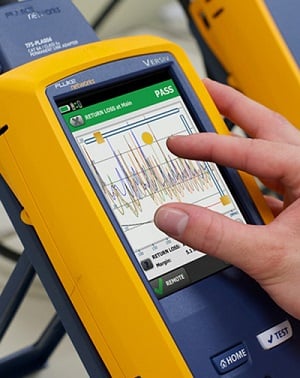
2. Precision fiber channel information: With the increasing use of short patch fibers and multi-fiber connectors, details on every link—loss, connector, and reflectance—are critical to ensuring performance. OTDRs with an attenuation dead zone of more than 3m are no longer applicable for testing datacenter fiber. Ultrashort dead zones are needed to find issues that jeopardize the link loss budget or cause serious signal degradation. In addition, fast problem resolution requires that faults and events be presented in a simple, graphical map so users at various skill levels can efficiently perform fiber troubleshooting and accelerate network recovery.
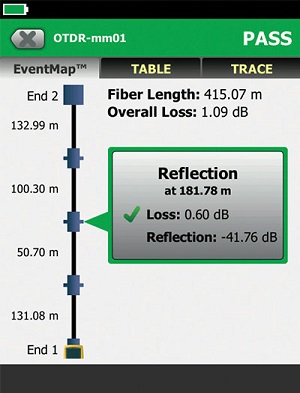
3. Effective planning and documentation: As datacenters grow and change, coordinating projects and ensuring that all fibers are installed with certified quality is challenging. There are a number of software applications available for project management, but until recently none have been integrated with an OTDR. Integrated project management capabilities with cable-by-cable granularity can save time and planning effort. Look for an OTDR with built-in project management capability that allows you to plan day-to-day activities without using a PC or laptop. You should be able to use a single tool to control, monitor, consolidate and document all test results.
OptiFiber® Pro: The Solution from Fluke Networks
The OptiFiber Pro OTDR from Fluke Networks is a dedicated fiber tester engineered specifically to address the datacenter needs of fiber professionals. Leveraging advanced optical innovation and inputs from both seasoned fiber testers and highly experienced user interface experts, the OptiFiber Pro provides a set of unique capabilities that begin paying off immediately. It increases work efficiency, reduces operational costs, and provides an unprecedented level of precision and detail about the fiber infrastructure.
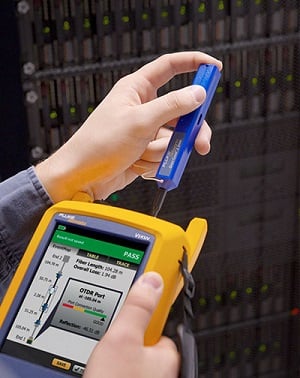
Key breakthroughs of OptiFiber Pro include:
- The first smartphone user-interface minimizes the learning curve and costs associated with interpreting test results while greatly reducing the intricacies of using an OTDR.
- Simplified “Datacenter” mode automates the process of setting test parameters such as wavelength and end-detection algorithms, significantly reducing set-up time and the complexity of learning how to troubleshoot datacenters.
- Ultra-short event and attenuation dead zone detects short connectors and patch cords typically used in datacenter environments, particularly in virtualized datacenters.
- Innovative EventMap™ view graphically shows all fiber events and allows any user to effectively characterize and troubleshoot any fiber infrastructure.
- Powerful built-in project management tools facilitates the assignment and tracking of all fiber testing jobs for multiple users, enhancing project tracking visibility and allowing cost-effective device sharing.
- LinkWare™ management software eases the burden of workflow management, documenting test results, and keeping the OTDR up to date with the latest software.
- Future-ready Versiv(TM) design supports copper certification to Category 8, fiber loss and inspection.
- SmartLoop™ technology enables the testing of two fibers in both directions, and averages the measurements as required by TIA-568.3-D in seconds - without taking the OTDR to the far end.
- Integrates with LinkWare™ Live to manage jobs and testers from any smart device.
Summary
Datacenter technology is advancing at a tremendous pace to meet the challenges of reliably delivering critical applications for enterprises. The integrity of the datacenter infrastructure relies upon the strength of the fiber network. Fluke Networks, with years of experience and leadership in developing Datacom testing and measurement devices, designed a superior enterprise OTDR solution for troubleshooting and certifying datacenter fiber networks. Not only does OptiFiber Pro save time for cable installers and network technicians, it also helps them to perform high-quality work that enhances their reputation and translates into new business or opportunities for advancement.
To learn more about OptiFiber Pro OTDR, visit our fiber testing solutions center at www.flukenetworks.com\optifiberpro
DSX CableAnalyzer™ Series Copper Certification– Accelerates every step of the copper certification process
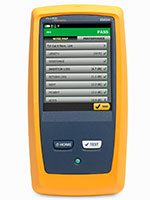 The DSX CableAnalyzer Series improves the efficiency of copper certification with unmatched speed for Cat 6A, 8, Class FA, I/II and all current standards (Intertek Verified to TIA Level 2G– the most stringent accuracy requirement). The ProjX™ system manages job requirements and progress from set-up to systems acceptance, making sure all tests are completed correctly; ensures jobs are done correctly the first time and helps tracks progress from set-up to systems acceptance. Taptive™ user interface simplifies set-up, and eliminates errors, graphically displays the source of failures including crosstalk, return loss and shield faults for faster troubleshooting. Compatible with Linkware™ Live. Linkware Live enables to easily track job progress, get real-time access to test results to quickly fix problems in the field, and easily transfer and consolidate test results from the tester to LinkWare™ PC Cable Test Management Software.
The DSX CableAnalyzer Series improves the efficiency of copper certification with unmatched speed for Cat 6A, 8, Class FA, I/II and all current standards (Intertek Verified to TIA Level 2G– the most stringent accuracy requirement). The ProjX™ system manages job requirements and progress from set-up to systems acceptance, making sure all tests are completed correctly; ensures jobs are done correctly the first time and helps tracks progress from set-up to systems acceptance. Taptive™ user interface simplifies set-up, and eliminates errors, graphically displays the source of failures including crosstalk, return loss and shield faults for faster troubleshooting. Compatible with Linkware™ Live. Linkware Live enables to easily track job progress, get real-time access to test results to quickly fix problems in the field, and easily transfer and consolidate test results from the tester to LinkWare™ PC Cable Test Management Software.
CertiFiber® Pro – Accelerates every step of the fiber certification process
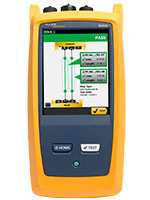 The CertiFiber Pro improves the efficiency of fiber certification with a 3 seconds, two fibers at both wavelengths. The. Taptive user interface simplifies set-up, eliminates errors and speeds troubleshooting. A set reference wizard ensures correct reference setting and eliminates negative loss errors. Built on the future-ready Versiv platform, CertiFiber Pro provides merged Tier 1 (Basic) / Tier 2 (Extended) testing and reporting when paired with OptiFiber Pro module. Aconvenient quad module supports both singlemode and multimode and is multimode Encircled Flux compliant. Copper certification and Wi-Fi Analysis and Ethernet troubleshooting modules are also available. Analyze test results and create professional test reports using LinkWare Management Software.
The CertiFiber Pro improves the efficiency of fiber certification with a 3 seconds, two fibers at both wavelengths. The. Taptive user interface simplifies set-up, eliminates errors and speeds troubleshooting. A set reference wizard ensures correct reference setting and eliminates negative loss errors. Built on the future-ready Versiv platform, CertiFiber Pro provides merged Tier 1 (Basic) / Tier 2 (Extended) testing and reporting when paired with OptiFiber Pro module. Aconvenient quad module supports both singlemode and multimode and is multimode Encircled Flux compliant. Copper certification and Wi-Fi Analysis and Ethernet troubleshooting modules are also available. Analyze test results and create professional test reports using LinkWare Management Software.
FI-7000® – 1-second automated PASS/FAIL certification of fiber end-faces
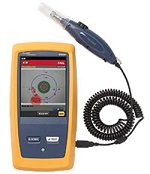 The FI-7000 FiberInspector Pro is a fiber optic inspection scope that allows you to inspect and certify fiber optic connector end-faces in 1 second so you can get the job done the first time. This fiber optic inspection scope provides automated PASS/FAIL certification take the guess work out of fiber inspection so anyone can be a fiber expert. FI-7000 offers graphical indication of problem areas caused by contamination, pits, chips, and scratches. Now you can easily certify fiber optic cable to industry standards - IEC 61300-3-35 and eliminate human subjectivity from end-face measurements; save fiber optic connector end-face views during certification process.
The FI-7000 FiberInspector Pro is a fiber optic inspection scope that allows you to inspect and certify fiber optic connector end-faces in 1 second so you can get the job done the first time. This fiber optic inspection scope provides automated PASS/FAIL certification take the guess work out of fiber inspection so anyone can be a fiber expert. FI-7000 offers graphical indication of problem areas caused by contamination, pits, chips, and scratches. Now you can easily certify fiber optic cable to industry standards - IEC 61300-3-35 and eliminate human subjectivity from end-face measurements; save fiber optic connector end-face views during certification process.




